This article is part of a larger series on CRM.
TABLE OF CONTENTSLead tracking is storing, organizing, and updating prospect data and sales activity information. To perform this process, you’ll need a sales leads tracking tool and then start by defining the types of data you want to collect. Once that’s established, keep the information updated as you generate, assign, qualify, and nurture leads and finalize sales deals. Here, we explore how to track sales leads and properly organize lead information and why it’s important to track them.
Tracking sales leads is essential to a standardized sales operation. We’ve created a free template to make it easier for you to get started. You can use this spreadsheet to organize prospects or guide you in defining and setting up your sales lead tracker.
FILE TO DOWNLOAD OR INTEGRATE
Tracking Sales Leads Template
Download as Google Sheets Download as Excel💡 Quick Tip: Customer relationship management (CRM) systems like Freshsales allow you to organize, prioritize, and engage your leads in a centralized platform. This provider also gives you to option to automate lead assignments and follow-ups.
Select Download TypeIf you would prefer to track your sales leads through alternative means, we will also go over how to keep track of sales and give insights on other tools and software with lead-tracking capabilities. No matter which tool you use, here’s how to track sales leads and organize their activity to ensure your teams are working with up-to-date information in seven easy steps:
The first thing to do is to determine the tool or method you’d like to use. Depending on your technical knowledge of sales leads software, the complexity of your sales process, and the amount of information you need to manage, there are a few routes you can take to track sales leads:
Customer relationship management (CRM) systems, such as Freshsales, offer an all-in-one pipeline tracking, task management, communication, and lead tracking system. Users can store information on leads and collaborate on sales tasks while creating reports on their progress, performance, and activity.
![]()
How to track sales leads in Freshsales (Source: Freshsales)
Arguably the easiest way to track leads, spreadsheet tools like Google Sheets or Microsoft Excel use a column and row table system to input prospect and activity information. From there, users can update cells, sort data, and share their sheets with other team members to view or edit. These platforms even offer CRM templates for sales data fields. Use our free lead tracking template to get started with this method.
![]()
Tracking sales leads on Google Sheets (Source: RulerAnalytics)
![]()
Tracking sales leads using Excel CRM template (Source: Vertex42)
Project management tools, such as monday.com and Trello, are among the best CRM alternatives. They give the simplicity a spreadsheet offers but also offer more dynamic visual options, such as Kanban or dashboard views. You can also use Trello as a CRM through its Crmble power-up feature.
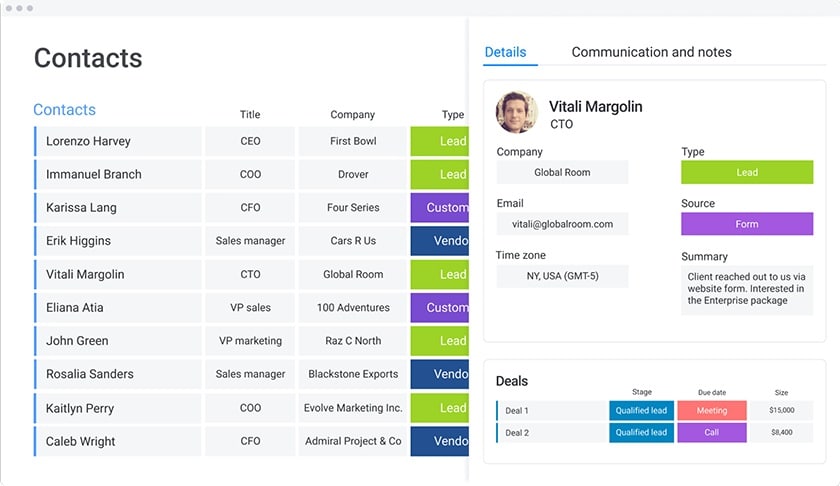
monday.com lead management and tracking system (Source: monday.com)
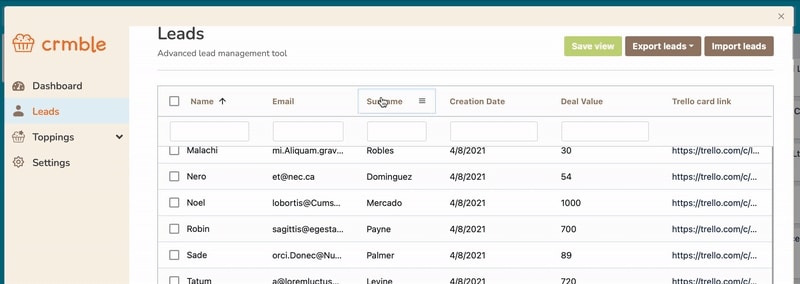
Trello Crmble leads list (Source: Trello)
Email tools like Mailchimp are excellent for storing email contact information as well as designing, deploying, automating, and analyzing email marketing campaigns. You can use an email marketing platform when you want to focus on creating branded email templates, which include welcome workflows, monthly newsletters, and promotional emails.
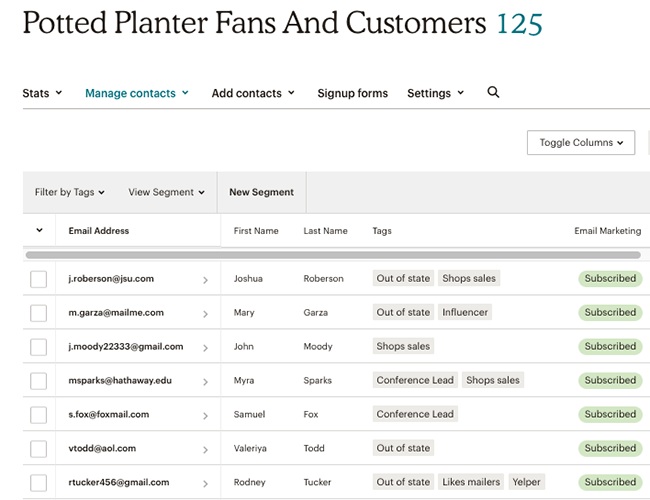
Mailchimp lead segment list (Source: Mailchimp)
While there are many methods for organizing sales information, 40% of sales professionals agree a customer relationship manager (CRM) provides them with a better way to align sales and marketing teams. No matter what type of CRM you choose for tracking your leads, the most important thing is that you and other users are able to store and update applicable data records as events take place. These include CRM records, spreadsheet cells, project management items, and email contact lists.
Pro tip: Looking for robust CRM software that meets your small business needs? Read our guide on how to choose a CRM system and download our comprehensive CRM e-book to learn more about choosing and implementing the right CRM for your team.
Once you’ve decided how to organize the prospect and deal information, there’s a small but necessary step of defining data fields before you can set up and begin tracking. Fields are where you collect information associated with a lead record. For example, an important data field for a lead is the lead contact’s first and last name. Below are some types of data fields you should define and include.
Identifiable InformationThe first type of data field involves contact information associated with a lead. This field helps identify a record because the information is unique to that specific lead. The most common examples you want to collect for each lead include their name, organization, address, email address, and phone number.
Lead SourceTracking lead sources helps you monitor where opportunities are coming from to help optimize marketing budgets and sales resources to the most effective channels. Some examples of lead sources frequently used include trade shows, networking events, social media, online ads, inbound calls, business referrals, online research, or a specific organization. Keep in mind that a lead source is simply where your prospects heard about you or first interacted with you.
Associated TagsTags are information attached to a record that identifies a group of prospects based on similar interests, priorities, or statuses. They help your sales process if you want to filter or share leads based on certain shared characteristics.
For example, say you wanted to identify certain contacts based on buyer preferences to help your sales reps when they engage them and the marketing team to nurture them. You might create one tag called “Price Sensitive,” one called “Product Usability Demanded,” and another called “Customer Service Focused.” As each lead comes in, you assign them one or two of these tags.
The advantage of tagging is that if you generate an email list to deploy a marketing campaign to nurture each of these leads, you can do it according to their preferences. In other words, you can filter and divide your lists based on those with the same tags.
Deal InformationDeal information fields include data regarding their purchase potential and product or service interest. Common examples include deal size ($) and the product line the lead is interested in. This category also encompasses any information that impacts pricing, such as the number of employees, which often dictates how much insurance, software, or a consulting service costs.
Pipeline Stage or ActivityThese data fields let you monitor where you are in the sales process with each opportunity. You might have established predefined pipeline stages that indicate the internal activities required to close a deal, such as lead qualification, nurturing, or sending proposals. Alternatively, you might take a more simplified approach and just take note of your interactions with them.
For example, if a prospect called into your business on August 1, you’d note in their record, “Aug 1: Lead generated-called with interest in products.” Then, if you followed up with them on September 1, you’d add to the record “Sept 1: Followed-up on lead by calling them, couldn’t speak but asked me to send an email, email sent.”
Once you’ve determined what to track, begin setting up your lead tracking system. Start with adding those data fields you find essential. If you’re using CRM software, each product will have default fields to work with or its own custom settings for adding and editing custom fields for each module.
Zoho CRM, for example, lets you select field types, such as single line text, date, email, or a check box, and then label the field with the relevant name, such as Social Security number, lead name, or lead source. Users can also edit properties for each field in the CRM if they require data entry for the record, want to prevent duplicates, or need to secure the data with encryption.

Zoho CRM custom data field types (Source: Zoho)
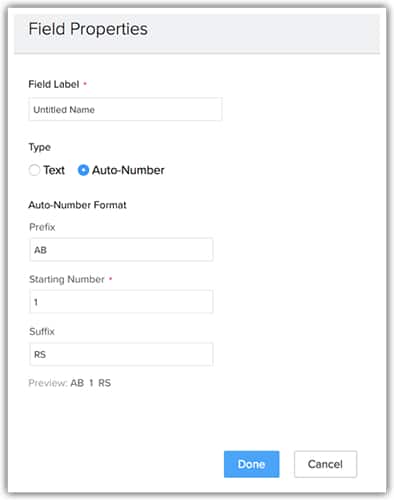
Zoho CRM labeling data field (Source: Zoho)
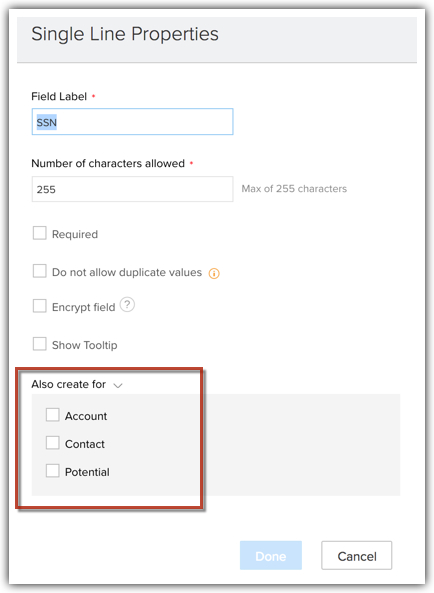
Zoho CRM data field properties (Source: Zoho)
Once all the fields are designed to your liking in the CRM, start adding contact and prospect records as leads are generated. Though you can manually enter data records, this can also be automated by linking a web form to your CRM system.
For example, HubSpot CRM allows you to customize forms for marketing campaigns, such as newsletter sign-ups, social media forms, or online ads. From there, if interested prospects submit their information, they automatically have their data transferred to the CRM as a lead record.

HubSpot CRM custom lead generation form (Source: HubSpot)
If you do, however, choose to take the manual route, make sure you add all of the information you initially require. For example, let’s say you were conducting online research to find prospects and set up your CRM process to require a phone number as a data field before a record can be created. In that case, you’d want to make sure you find that phone number, even if it just means using their organization’s primary number.
As leads begin pouring in, have a process ready that assigns them to a dedicated sales rep or account executive. You might consider doing this manually; however, if the volume of potential customers coming in is high, it becomes challenging to stay organized.
Some CRMs, such as Zoho CRM, have automated lead assignment features you can use. Users can configure their system to assign opportunities and notify specific reps based on characteristics such as lead source, product line, or potential deal size.
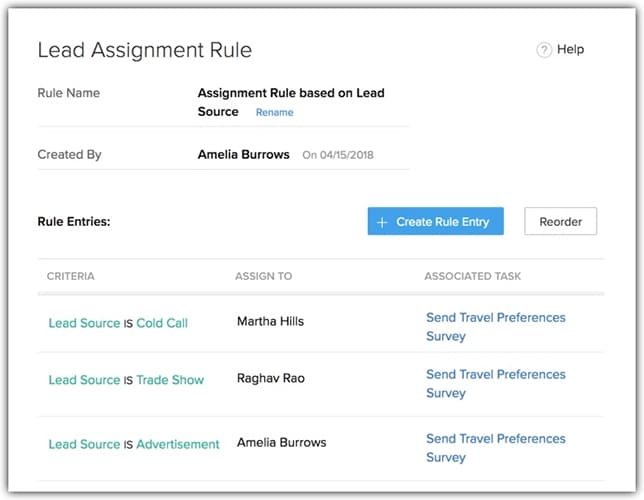
Zoho CRM lead auto-assignment rules (Source: Zoho)
If you’re using a spreadsheet or CRM alternative, indicate which rep is responsible. Once assigned, your sales team members can begin doing initial outreach via cold calling or email and update their records or cells on each lead’s progress. For instance, they can update the pipeline status on the record if they call and schedule a sales presentation or give a product demo.
Most prospects won’t give you a straight yes or no answer immediately. One estimate shows that 63% of leads who inquire won’t convert until at least three months. During that time between the initial conversations and deal-closing activity, continuously nurture your leads. Nurturing is maintaining relationships with potential and current customers through communications.
You can use automated email marketing campaigns to constantly stay in touch with those in the pipeline. Additionally, your sales reps can do more personalized nurturing by sending direct emails to prospects or making follow-up phone calls to see where your leads stand.
Just as you would doing the lead generation and assignment steps, log your activity in your records, spreadsheet tables, or project boards so anyone can see where a prospect is in the pipeline. CRMs, including Salesforce, have activity tracking in their lead records. From a profile, users can document notes to track sales calls, emails, tasks, or event information.
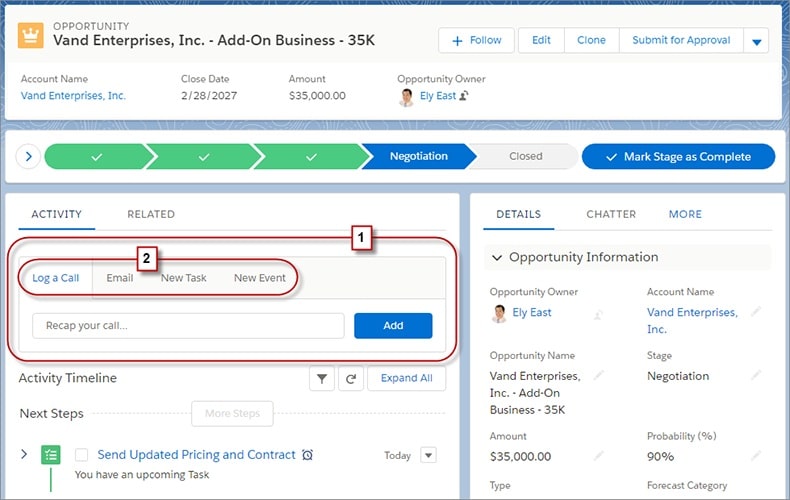
Salesforce leads record with activity tracking (Source: Salesforce)
Finally, lead prioritization is the last step in the lead tracking process. This refers to focusing efforts and time on prospects with the best chance of becoming won customers. You can use your instincts to see which leads stand out as great opportunities based on your interactions and customer attributes such as buying power, fit for offerings, and interest expressed—all of which you have been tracking.
A more advanced method, however, is using what’s called lead scoring, which uses a point system to identify the best leads. While you can design criteria by hand, you’ll gain more streamlined and automated results by doing it in a CRM system. Freshsales is an excellent example of a CRM that lets you customize lead score criteria to add points based on activity and lead attributes, then assign points as events take place.
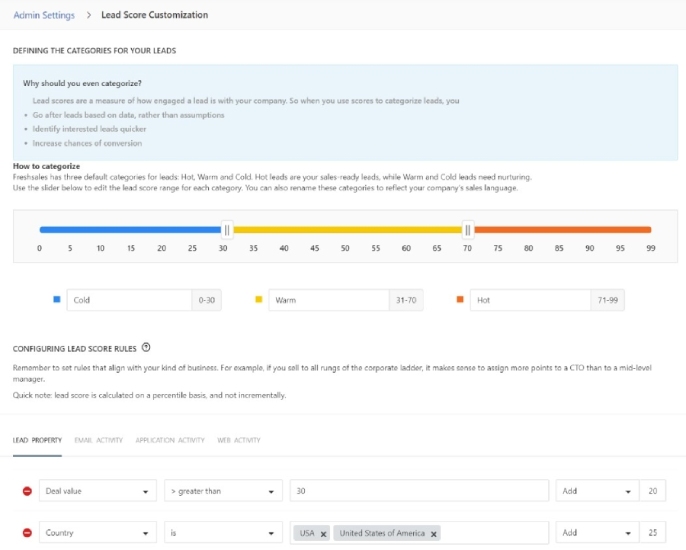 how Freshsales users can configure lead score criteria." width="686" height="550" />
how Freshsales users can configure lead score criteria." width="686" height="550" />
Freshsales configuring lead score criteria (Source: Freshsales)
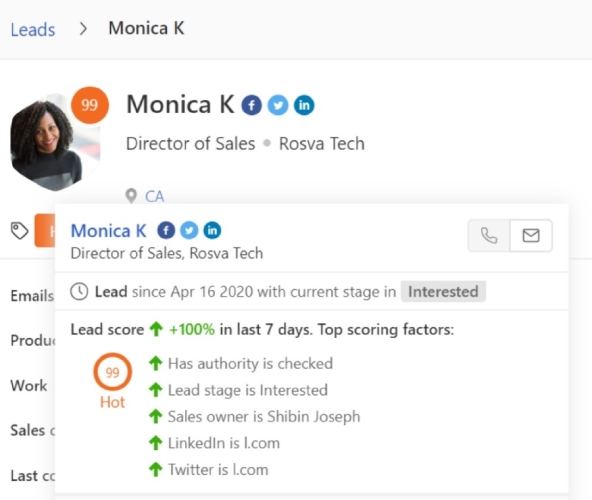
Freshsales lead with score (Source: Freshsales)
Sales lead tracking is considered its own stage in the lead management process. After a lead is generated and their information captured, you need to have a system that organizes and updates that data as they go through the sales process. The importance and benefits of tracking sales leads can be categorized into a few main reasons:
Keeps Contact Data OrganizedHaving a centralized system that stores the names, company info, addresses, phone numbers, and email addresses of a lead makes it easy to find information when you need to contact them or find their data record.
Lets You View Activity HistoryTracking the activity of leads interacting with your brand or sales reps keeps you in the loop and up to date on when you last engaged them—allowing you to plan your next campaign or outreach tasks.
Allows You to Evaluate Deal Progress & Pipeline HealthTreating each lead as a trackable sales deal undergoing the sales process lets you view individual pipeline stage statuses for each lead as well as the total number of leads within each stage. It also enables you to evaluate conversion rates within the pipeline to see how effective your sales team is at closing deals.
Helps Prevent Lost Sales OpportunitiesTracking leads and assigning them to sales reps ensures someone is held accountable in the event an opportunity is lost due to a lack of follow-up or nurturing. In addition, tracking sales data helps businesses identify which of their product is selling well and which ones are underperforming. This way, they can zero in on the opportunities that need more nurturing.
Enables You to Create Marketing SegmentsIt is important to store contextual information about a lead, such as their job title, industry, product needs, or common behaviors. Doing this lets you categorize them into marketing segments where you can sell to them in a certain way or deploy specific marketing campaigns toward them.
Pro tip: Customer personas are excellent tools for determining your ideal buyers and your strategies for targeting them. Our guide on creating a customer persona teaches you how to define your ideal targets and use lead-tracking tools to see who fits into what segment.
If you’re not using a CRM system, you can track leads manually using Google Sheets or a Microsoft Excel spreadsheet template. You can also use project management tools like monday.com and email marketing platforms like Mailchimp to track your sales leads. This provider has a feature called Track with Mailchimp that gathers data about landing pages or website activities, saves the data on contact profiles, and lets you use it to segment audiences.
What should a lead tracker include?A lead tracker should include identifiable information about leads, such as their name, organization, address, email address, and contact number. It should also have the lead source, associated tags, deal information, and pipeline stage or relevant activity.
Why is tracking sales leads important?It is important to track leads to obtain relevant information that can help your sales team drive conversions. These include data on how the leads contacted your company and what their pain points are. You can use these details to personalize your outreach efforts and get better engagement.
Tracking sales leads is storing and updating prospect information as they’re generated and undergo the sales process. It’s essential to keep your sales data organized to ensure reps have access to the most recent and relevant information to work with. A robust lead tracking system requires you to select a method you’re comfortable with, such as a CRM, identify the information you want to store, and keep updating records as events take place.